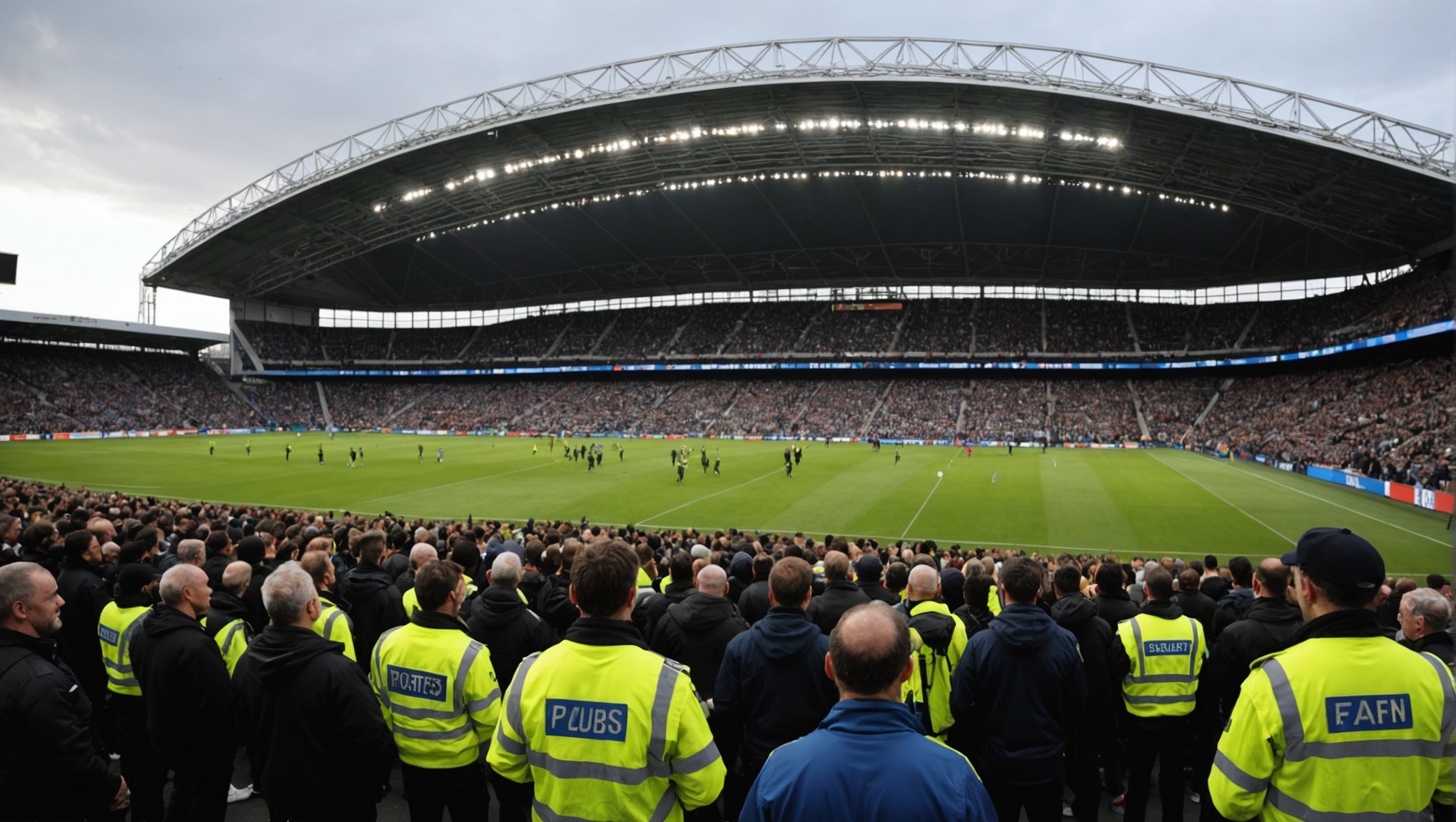Importance of Stadium Security
Stadium safety is an essential concern for organisers and attendees alike. Ensuring the security of football stadiums is of utmost significance due to the sheer number of people gathered in one place. This requires effective crowd control and comprehensive security measures to maintain order and safety.
With stringent security measures in place, fans are more likely to feel secure, positively impacting their overall experience. Secure environments contribute to higher attendance rates, as safety remains a crucial consideration for many spectators when deciding to attend events. Well-implemented crowd control strategies help manage large crowds efficiently, avoiding potential hazards and ensuring smooth, comfortable event experiences for everyone.
Also to discover : Building Player Loyalty: Strategic Contract Management Tactics for Football Clubs
The psychological aspect of security is also worth noting. When fans feel confident about the safety of their surroundings, they can fully engage in the event’s excitement without anxiety or stress. This creates a more enjoyable atmosphere, enhancing overall fan behaviour and participation. Hence, ensuring adequate stadium safety measures not only protects individuals but also cultivates a vibrant, energetic environment, enriching the football experience for all attendees.
Effective Surveillance Systems
In modern security, CCTV Security and Monitoring Technology play vital roles, especially in extensive venues like stadiums. Various types of surveillance systems are tailored for such environments, ensuring comprehensive coverage and enhanced safety.
Topic to read : Boosting Player Loyalty: The Role of Comprehensive Mental Health Initiatives in Football Clubs
Types of Surveillance Systems
Commonly, stadiums rely on CCTV Security systems, including fixed cameras, PTZ (pan-tilt-zoom) cameras, and thermal imaging technology. Real-time Surveillance is achieved through these diverse tools, offering both visual and thermal perspectives to effectively monitor large crowds and extensive areas.
Benefits of Advanced Monitoring
Advanced Monitoring Technology brings several advantages to stadium security. It allows for real-time incident response, ensuring any incidents, like unauthorized access or crowd disturbances, are addressed promptly. This rapid response capability is crucial in maintaining public safety and preventing potential threats.
Integrating AI Technology
The integration of AI enhances the ability of surveillance systems to predict and identify dangers. AI-powered analytics can discern unusual behaviors or patterns that might indicate security risks. As AI learns from past data, real-time Surveillance becomes more effective, bolstering defense mechanisms against both accidental and intentional incidents. It essentially transforms traditional CCTV Security into a proactive defense tool.
Crowd Management Strategies
Successfully managing large gatherings, especially at events, requires a calculated approach to crowd management. Ensuring safety and enjoyment for attendees demands attention to fan behavior and event coordination.
Pre-Event Planning
Effective crowd management begins long before attendees arrive. Pre-event planning is crucial, incorporating crowd management strategies tailored to the event’s nature and anticipated fan behavior. It’s essential to consider venue layout and keep access points clear. This involves simulating crowd scenarios to pinpoint potential congestion areas, ensuring emergency exits are adequate, and planning routes for efficient movement.
Crowd Flow Techniques
Implementing robust techniques for enhancing crowd flow is a linchpin in reducing congestion. Organisers often rely on strategically placing signage and barriers to guide attendees. Clear instructions can mitigate confusion, while alternate pathways and staggered entry times help manage traffic and improve overall satisfaction. These proactive strategies are instrumental in controlling fan behavior during the event.
Role of Security Personnel
Security personnel play a pivotal role in crowd management. Their training includes understanding fan behavior and anticipating issues. Skilled personnel monitor hotspots and intervene when necessary, fostering a safe environment. The presence of a well-prepared security team reassures guests, maintaining order through visible and responsive actions.
Emergency Response Plans
Developing comprehensive emergency preparedness plans for stadiums is essential for effective crisis management. These plans should detail incident response strategies that encompass various emergency scenarios, ensuring both safety and efficiency.
Developing Comprehensive Plans
Begin by conducting a risk assessment to identify potential hazards. Next, create detailed incident response procedures that address specific emergencies such as fire, weather events, or security threats. Collaboration with stakeholders, including facility managers and security personnel, helps ensure plans are thorough and inclusive.
Drills and Training Exercises
Implementing regular drills and training exercises is crucial for staff readiness in emergencies. These exercises simulate real-life scenarios, allowing personnel to practice response strategies and identify areas for improvement. Routine drills help reinforce roles and procedures, ensuring that staff act quickly and efficiently during an actual crisis.
Communication with Local Authorities
Establishing clear communication channels with local law enforcement and emergency services is vital for seamless collaboration during a crisis. Coordinate with these entities to share emergency plans and response roles, ensuring that all parties are prepared to work together effectively. Regular meetings and joint exercises can strengthen these relationships, ultimately enhancing the stadium’s overall emergency preparedness.
Technology Solutions for Security Enhancement
In the context of large venues like stadiums, Security Technology is fundamental for ensuring not only safety but also a seamless spectator experience. Access Control Systems stand out as a vital component of stadium security. These systems employ smart gates and facial recognition to manage crowd entry efficiently, reducing congestion and enhancing security by preventing unauthorized access.
When it comes to personal safety, Mobile Safety Applications have emerged as indispensable digital solutions. These apps empower attendees by providing real-time information about emergency exits, first aid locations, and safety alerts. Users can communicate directly with security authorities, strengthening the immediate response during crises.
Further, the sports industry is setting trends with Innovations in Fan Engagement technology. These innovations incorporate augmented reality and live social media feeds to offer immersive experiences while maintaining focus on safety measures. Features like geo-tagged locations ensure fans adhere to restricted areas, fostering a secure yet engaging environment.
The intersection of technology with security does not only prevent threats but also enriches the overall fan experience. Through these cutting-edge solutions, stadiums can create an environment where security and enjoyment coexist.
Case Studies and Best Practices
Exploring security success stories from top football clubs provides valuable insights. These case studies highlight innovative measures that have proven effective in assuring stadium safety and enhancing fan experience.
Examples from Leading Football Clubs
Several leading clubs have implemented pioneering practices. For instance, Tottenham Hotspur’s modern stadium uses advanced biometric systems to improve security by curbing unauthorized access. Similarly, Bayern Munich has invested heavily in AI surveillance, effectively predicting and preventing potential threats. Such case studies showcase how technology can bolster safety, creating safer environments for all attendees.
Lessons Learned from Past Incidents
Looking at past security breaches reveals valuable lessons. For instance, a lack of coordination between security personnel and local law enforcement was identified as a critical issue in the infamous 1985 incident at Heysel Stadium. This prompted revised protocols emphasizing better collaboration and communication, thereby strengthening stadium security measures. Learning from past experiences is crucial for crafting effective security policies.
Comparative Analysis of Different Approaches
Football clubs adopt various approaches to managing stadium security, each with its trade-offs. Comparative analysis shows clubs employing a balance between high-tech solutions and traditional methods, such as increased personnel. While technology offers precise monitoring, human presence ensures a proactive response. This synthesis enables clubs to tailor security measures to their specific needs, ensuring efficient protection efficacies.
Engaging Fans in Safety Measures
Engaging fans in safety measures can significantly enhance their overall experience at stadiums. To accomplish this, Fan Engagement is crucial and involves clear Communication Strategies. By involving fans directly, they can become active participants in maintaining a safe environment.
Importance of Fan Participation
Participating in safety measures empowers fans, making them more aware and proactive. But why is Safety Awareness among fans so important? Because fans who understand safety protocols can react swiftly in emergencies, ensuring both personal and communal safety. Educating them with clear information strengthens the collective responsibility at events.
Strategies to Educate Fans
Implementing effective Communication Strategies ensures fans have a comprehensive understanding of safety practices. Strategies include game-day announcements, engaging social media content, and visual aids like signage around the venue. Communicative platforms should be diverse, allowing accessibility for all fans, ensuring the message is both received and well understood.
Feedback Mechanisms
Establishing robust feedback mechanisms is key to continuing improvement. What methods can collect input from fans on safety experiences? Using digital surveys, suggestion boxes, and interactive sessions during events are practical ways. Feedback not only highlights concerns but also encourages fans to be candid about their safety experiences, paving the way for enhancements.













